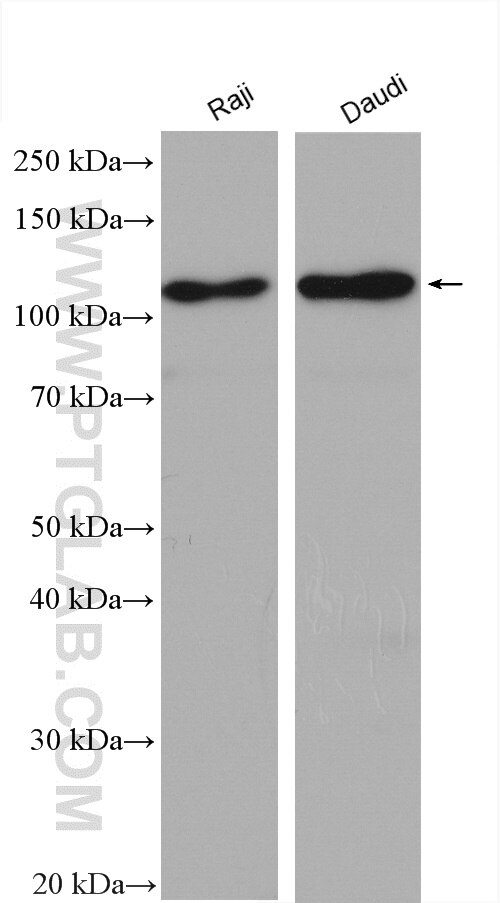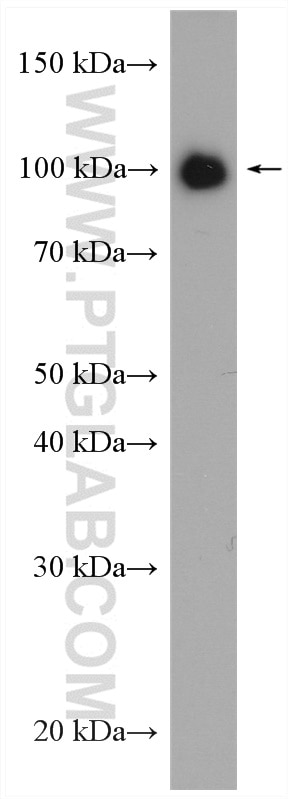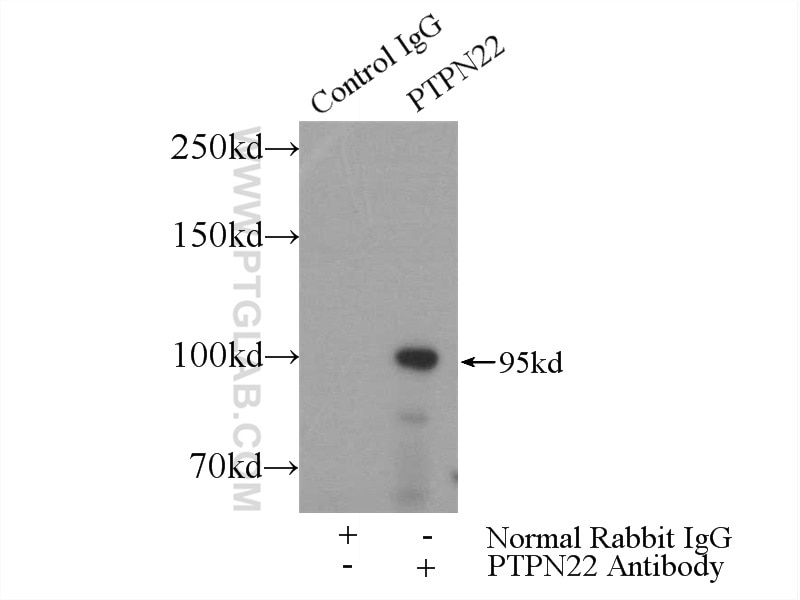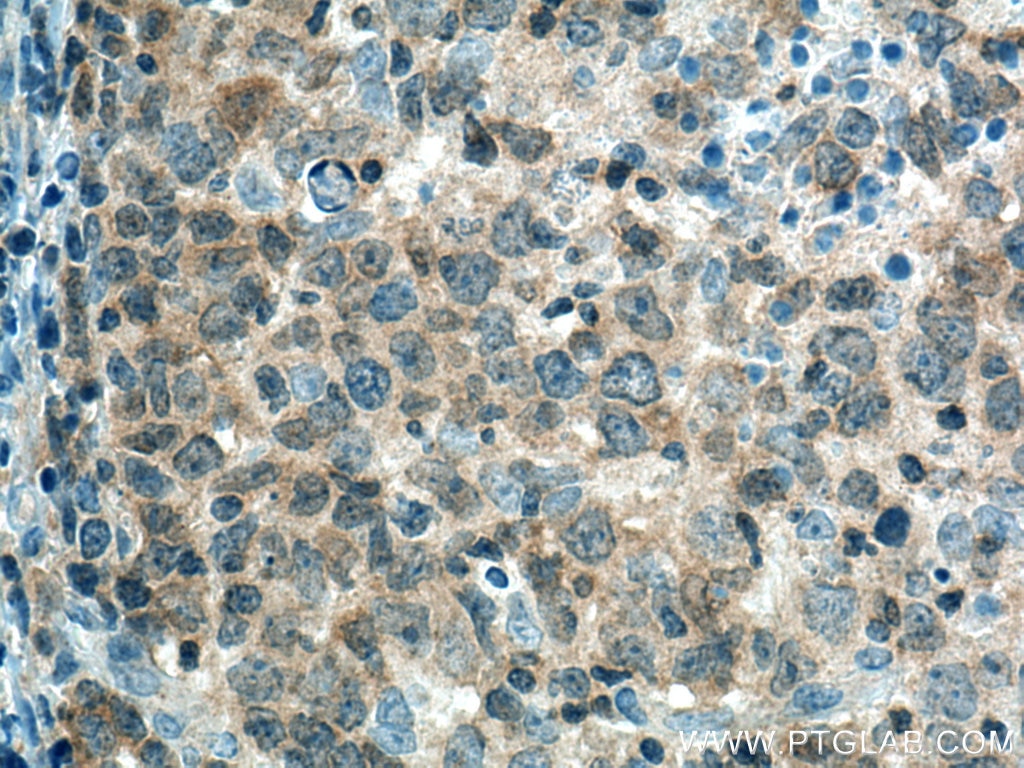Anticorps Polyclonal de lapin anti-PTPN22
PTPN22 Polyclonal Antibody for WB, IP, IHC, ELISA
Hôte / Isotype
Lapin / IgG
Réactivité testée
Humain, rat, souris
Applications
WB, IP, IF, IHC, ELISA
Conjugaison
Non conjugué
N° de cat : 11783-1-AP
Synonymes
Galerie de données de validation
Applications testées
| Résultats positifs en WB | cellules Daudi, cellules Jurkat, cellules Raji |
| Résultats positifs en IP | cellules Jurkat |
| Résultats positifs en IHC | tissu de lymphome humain, il est suggéré de démasquer l'antigène avec un tampon de TE buffer pH 9.0; (*) À défaut, 'le démasquage de l'antigène peut être 'effectué avec un tampon citrate pH 6,0. |
Dilution recommandée
| Application | Dilution |
|---|---|
| Western Blot (WB) | WB : 1:500-1:2000 |
| Immunoprécipitation (IP) | IP : 0.5-4.0 ug for 1.0-3.0 mg of total protein lysate |
| Immunohistochimie (IHC) | IHC : 1:50-1:500 |
| It is recommended that this reagent should be titrated in each testing system to obtain optimal results. | |
| Sample-dependent, check data in validation data gallery | |
Applications publiées
| WB | See 3 publications below |
| IF | See 1 publications below |
| IP | See 1 publications below |
Informations sur le produit
11783-1-AP cible PTPN22 dans les applications de WB, IP, IF, IHC, ELISA et montre une réactivité avec des échantillons Humain, rat, souris
| Réactivité | Humain, rat, souris |
| Réactivité citée | rat, Humain, souris |
| Hôte / Isotype | Lapin / IgG |
| Clonalité | Polyclonal |
| Type | Anticorps |
| Immunogène | PTPN22 Protéine recombinante Ag2397 |
| Nom complet | protein tyrosine phosphatase, non-receptor type 22 (lymphoid) |
| Masse moléculaire calculée | 82 kDa, 92 kDa |
| Poids moléculaire observé | 100-110 kDa |
| Numéro d’acquisition GenBank | BC017785 |
| Symbole du gène | PTPN22 |
| Identification du gène (NCBI) | 26191 |
| Conjugaison | Non conjugué |
| Forme | Liquide |
| Méthode de purification | Purification par affinité contre l'antigène |
| Tampon de stockage | PBS avec azoture de sodium à 0,02 % et glycérol à 50 % pH 7,3 |
| Conditions de stockage | Stocker à -20°C. Stable pendant un an après l'expédition. L'aliquotage n'est pas nécessaire pour le stockage à -20oC Les 20ul contiennent 0,1% de BSA. |
Informations générales
PTPN22(Tyrosine-protein phosphatase non-receptor type 22) is also named as LyP,PEP,PTPN8.It belongs to the protein-tyrosine phosphatase family and non-receptor class 4 subfamily.It acts as negative regulator of T-cell receptor (TCR) signaling.Defects in PTPN22 are a cause of susceptibility to systemic lupus erythematosus (SLE). It has some isoforms produced by alternative splicing with calculated molecular mass of 79-92 kDa, and apparent molecular mass of 100-110 kDa.
Protocole
| Product Specific Protocols | |
|---|---|
| WB protocol for PTPN22 antibody 11783-1-AP | Download protocol |
| IHC protocol for PTPN22 antibody 11783-1-AP | Download protocol |
| IP protocol for PTPN22 antibody 11783-1-AP | Download protocol |
| Standard Protocols | |
|---|---|
| Click here to view our Standard Protocols |
Publications
| Species | Application | Title |
|---|---|---|
J Exp Med NLR Nod1 signaling promotes survival of BCR-engaged mature B cells through up-regulated Nod1 as a positive outcome. | ||
Sci Signal The adaptor protein TRAF3 inhibits interleukin-6 receptor signaling in B cells to limit plasma cell development. | ||
Pflugers Arch Anandamide produced by Ca(2+)-insensitive enzymes induces excitation in primary sensory neurons. |





